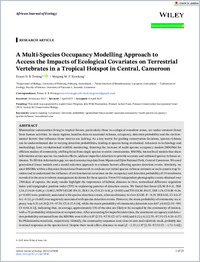A Multi-Species Occupancy Modelling Approach to Access the Impacts of Ecological Covariates on Terrestrial Vertebrates in a Tropical Hotspot in Central, Cameroon
DOKPE
- Fotsing, Ernest Dadis Bush ORCID University of Fribourg
- Kamkeng, Meigang M. F. University of Yaoundé 1, Cameroon
- 2025
Published in:
- African Journal of Ecology. - 2025, vol. 62, no. 4
camera trapping
covariates detection probability
generalised linear model
mammal community
multi-species occupancy
species richness
transitional zone
English
Mammalian communities living in tropical forests, particularly those in ecological transition zones, are under constant threatfrom human activities. In many regions, baseline data on mammal richness, occupancy, detection probability and the environ-mental factors that influence these metrics are lacking. As a key metric for guiding conservation decisions, species richnesscan be underestimated due to varying detection probabilities, leading to species being overlooked. Advances in technology andmethodology have revolutionised wildlife monitoring, fostering the increase of multi-species occupancy models (MSOMs) forefficient studies of community, shifting focus from single species to entire communities. MSOMs, hierarchical models that shareinformation across species via random effects, address imperfect detection to provide accurate and unbiased species richness es-timates. To fill this information gap, we used cameras trap data from Mpem and Djim National Park, Central Cameroun. We usedgeneralised linear models and a model selection approach to evaluate factors affecting species detection events. Similarly, weused MSOMs within a Bayesian hierarchical framework to evaluate our initial species richness estimate at each camera trap lo-cation and to understand the influence of environmental covariates on the occupancy and detection probability of 19 vertebratesrecorded in the area to inform management decisions for these species. From 915 independent photographic events obtained over1700 days of capture, the study results highlight the importance of habitat, distance to river, normalised difference vegetationindex and topographic position index (TPI) in explaining patterns of detection events. We found that forest (GLM: B 0.31, IRR1.36, CI 0.14–0.48, p < 0.001), NDVI (GLM: B 0.31, IRR 1.36, CI 0.21–0.41, p < 0.001) and TPI (GLM: B 0.17, IRR 1.19, CI 0.08–0.26,p < 0.001) were positively associated with species detection events, whereas distance to river (GLM: B −0,19, IRR 0.83, CI 0.0.27to (−0.11), p < 0.001) was negatively associated with species detection events. However, the mean probability of community occu-pancy was 0.33 ± 0.10 [2.5%–97.5% CI: 0.17, 0.54], while the mean probability of community detection was 0.07 ± 0.02 [2.5%–95%CI: 0.04, 0.12], indicating that, on average, approximately 33% of the sites are likely to be occupied by the community of interest,with a 7% probability of detection at occupied sites. After accounting for imperfect detection, the maximum occupancy and detec-tion probability estimated from the MSOMs were 0.88 ± 0.07 (2.5%–97.5% CI: 0.71–0.98) and 0.22 ± 0.2 (2.5%–97.5% CI: 0.18–0.27)for Philantomba monticola, respectively. Globally, the community responses were close to zero and relatively weak, probably dueto mixed responses at the species level. Despite their weak effect, distance to road (β: −1.53 ± 1.97 [2.5%–97.5% CI: −1.72–5.62] and NDVI (β: −0.09 ± 0.22 [2.5%–97.5% CI: −0.50–0.38]) had a negative significant effect on occupancy. However, there were sig-nificant responses at the species level with Cephalophus nigrifrons, for example, exhibiting a strong response to NDVI. This studycontributes to baseline information on the ecology of mammal communities in Central Cameroon and supports the need forfuture multi-season surveys to understand the influence of temporal factors on community occupancy and richness in the area.
- Faculty
- Faculté des sciences et de médecine
- Department
- Département de Biologie
- Language
-
- English
- Classification
- Biology, life sciences
- License
- Open access status
- green
- Identifiers
- Persistent URL
- https://folia.unifr.ch/unifr/documents/331736
Statistics
Document views: 72
File downloads:
- africanjournalofecology-2025-fotsing_amultispeciesoccupancymodelling: 142
